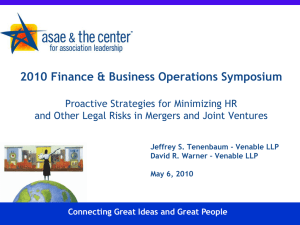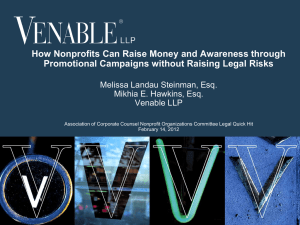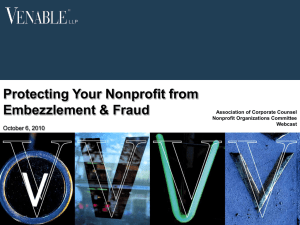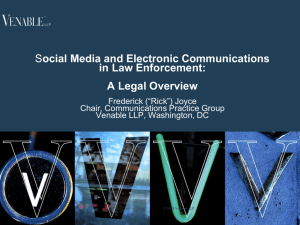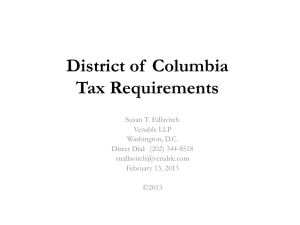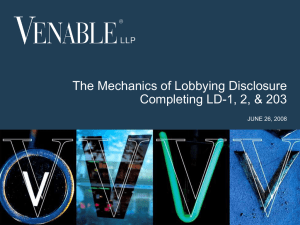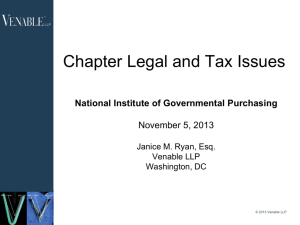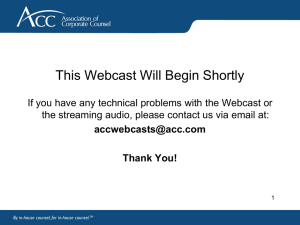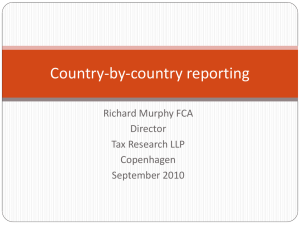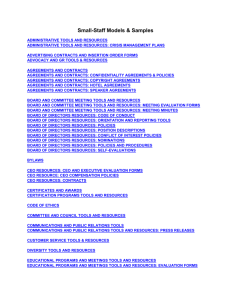The Top Four Legal Risk Management Issues Facing
advertisement
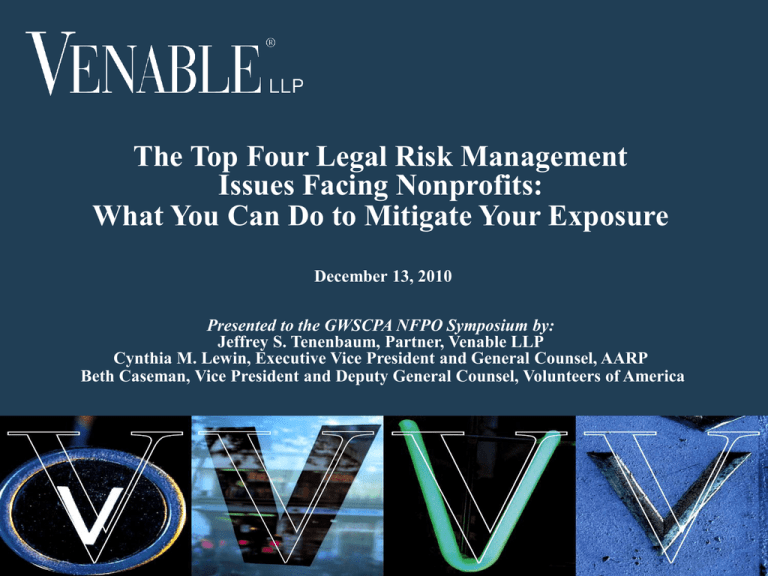
The Top Four Legal Risk Management Issues Facing Nonprofits: What You Can Do to Mitigate Your Exposure December 13, 2010 Presented to the GWSCPA NFPO Symposium by: Jeffrey S. Tenenbaum, Partner, Venable LLP Cynthia M. Lewin, Executive Vice President and General Counsel, AARP Beth Caseman, Vice President and Deputy General Counsel, Volunteers of America 1 Social Media “Enjoy the Buzz but Don’t Get Stung” Great opportunity but not without risk Not just the Wild West out there – Federal Trade Commission rules on endorsements and testimonials – National Labor Relations Board new guidance Develop a policy that works for your culture – Business use – Personal use for business purposes – Personal use unrelated to business purposes © 2010 Venable LLP Page 2 Your Social Media Policy Right tone for your culture – How much of a “personality” is allowed? Transparency about identity as employee or volunteer Disclaimer about not speaking on behalf of the organization Refer to your workplace guidelines or code of ethics If you want to seize the opportunity, offer training or a messaging center © 2010 Venable LLP Page 3 Employment Liability Key Areas of Risk 1. Terminations – – – Use of progressive discipline Review process prior to termination Exit interviews 2. Performance reviews and counseling – – – Regularity and content of reviews Documentation of counseling Consistency of disciplinary action © 2010 Venable LLP Page 4 Employment Liability Key Areas of Risk 3. Wage and hour compliance (FLSA) 4. FMLA practices 5. Employee privacy/monitoring © 2010 Venable LLP Page 5 Employment Liability Steps to Mitigate Risk Routine supervisor training Increased documentation of performance management and progressive discipline Pre-termination review by counsel Legal review of existing HR policies, employee handbook Perception of fairness is key! © 2010 Venable LLP Page 6 Risk from Affiliated Entities State chapters or affiliates – How much separation is “right” for you? – Are you liable for their activities? – Reputational risk What steps can you take to address this risk? – – – – Clarity on the relationship in the governing documents Clarity to the public in communications Insurance Education, training and counsel © 2010 Venable LLP Page 7 Risk from Related Tax-Exempt and Taxable Entities Meeting the IRS standards for separation while still functioning in an efficient manner – finding the right balance and protecting your tax exemption – One overarching strategic plan with sub-plans – Separate boards (with overlap), be scrupulous about separate finances – What is separate day-to-day management? – PACs and taxable subsidiaries require special care Probably not as efficient as if you were one organization, but there are counterbalancing considerations – the price you pay … © 2010 Venable LLP Page 8 Risk from Related Tax-Exempt and Taxable Entities Tax-exempt purposes / substantial non-exempt purposes Private inurement / excessive compensation / intermediate sanctions Private benefit (501)(c)(3) organizations only) © 2010 Venable LLP Page 9 Corporate Governance Emphasis on increased transparency and accountability – Heightened focus on governance in IRS Form 990 – Charity Navigator/BBB Wise Giving standards – Reputational risk paramount -- poor governance, once exposed, leads to loss of public confidence – Increased audit risk? Legal risks associated with failure to comply with articles of incorporation and bylaws, and state nonprofit corporation law (of state of incorporation) Fiduciary duties of board members: duties of care, loyalty, and obedience © 2010 Venable LLP Page 10 Corporate Governance What steps can you take to address this risk? – Provide orientation and training for your board and senior management – directors should be informed, ask questions, attend meetings; directors and senior managers should be aware of governing documents and applicable law – Don’t rely on your tax preparer alone to prepare your Form 990 responses; involve senior program personnel, communications, legal – Don’t just check the box! Ensure policies – once adopted – are effectively implemented (e.g., whistleblower protection, document retention, conflicts of interest, compensation) © 2010 Venable LLP Page 11 Questions and Discussion 12 Jeffrey S. Tenenbaum, Partner, Venable LLP jstenenbaum@Venable.com t 202.344.8138 Cynthia M. Lewin, Executive Vice President and General Counsel, AARP clewin@AARP.org t 202.434.2375 Beth Caseman, Vice President and Deputy General Counsel, Volunteers of America bcaseman@VOA.org t 703.341.5000 To view Venable’s index of articles and PowerPoint presentations on association and nonprofit legal topics, see www.venable.com/associations/publications. 13
